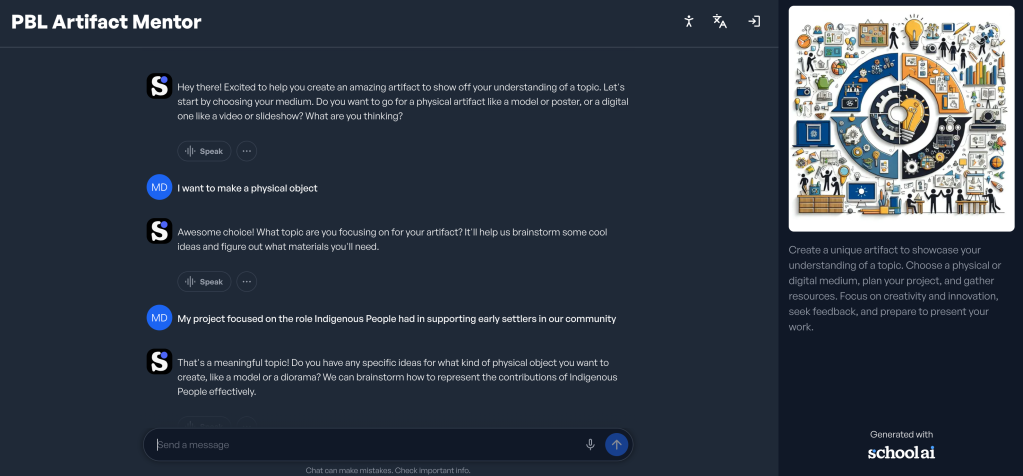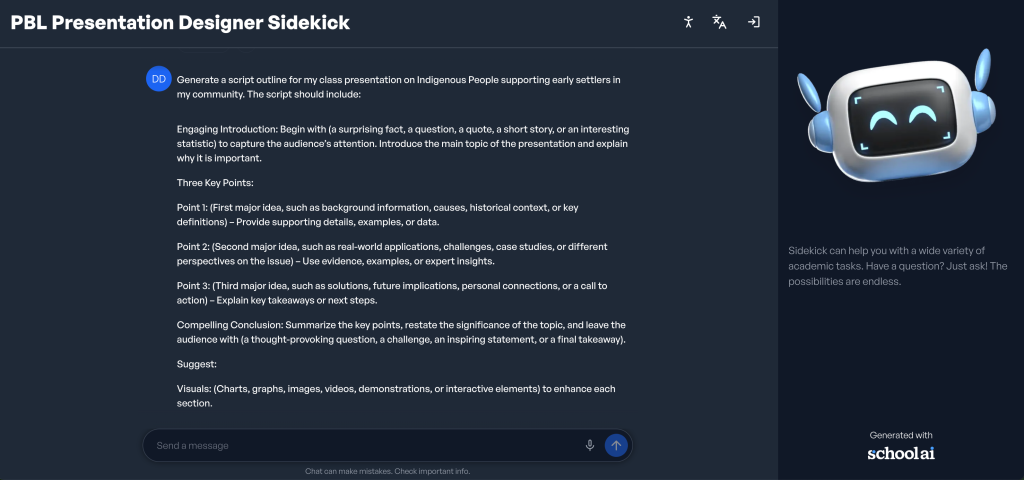How Students Can Use AI in Project-Based Learning
Teachers can guide students to leverage AI for feedback in choosing and presenting a learning artifact—and they still create that themselves.
Your content has been saved!
Go to My Saved Content.One of the most important things to me when considering an edtech tool is considering how the tool will integrate with the pedagogical practices I already have in place. It should not be about adjusting pedagogy to make the edtech tools take center stage, but instead leveraging those tools to make learning more powerful and more efficient. As an educator who truly believes in the power of project-based learning (PBL), I wanted to find ways to integrate artificial intelligence (AI) as a tech tool into the classroom practices I already know work.
AI can support both teachers and students in PBL units in many ways, and integrating AI into your teaching practice doesn’t have to be an overwhelming obstacle. I have two solid examples of how you can have students use AI in alignment with a PBL-focused approach to instruction.
Using AI to Get Started: Choosing an Artifact
Project-based learning pain point: Students often have a hard time deciding what their artifact is going to be for their final presentation. A major part of PBL is the creation of an artifact, something physical or digital, to demonstrate learning.
While teachers would love to help each student individually, this can be very time-consuming. Here’s where AI comes in. Students can use AI to engage in a personalized chat that guides them through the selection process.
Similar to how a student might discuss their ideas with their teacher, a student could engage in this chat with AI, freeing up time for teachers to provide other kinds of support and empowering students to solve problems on their own. Here is a prompt that a student could use to start the conversation:
Act as a project-based learning guide and help me navigate the selection, designing, and building of an artifact that I can create to demonstrate my understanding of (topic). The artifact should (class or assignment guidelines), and I should be able to present it when it is done.

It is very important to remember that the students should not be sharing personal identifying information when using an AI chatbot. For teachers, it is important to know what your school has allowed when it comes to AI use in the classroom. There are many different AI companies out there that are designed for the classroom and are compliant with the Children’s Online Privacy Protection Act and Family Educational Rights and Privacy Act. I used SchoolAI in my classroom with students and was able to create the chatbots for them to use for free. Here is an example of a space that teachers can remix and share with their students.
Students will now be able to solve the artifact problem on their own time and no longer need to wait for a teacher to guide them through the process. The teacher enters the process at the end to provide any final thoughts and guidance on the final artifact idea instead of having to go through the entire process. The time saver leads to higher engagement and a better final artifact for the PBL project.
Using AI to Present the Project
Project-based learning pain point: Students find it difficult to build a presentation for the culmination of their PBL lesson.
Students may also struggle with the presentation aspect of PBL, due to anxiety, discomfort speaking in public, or lack of experience. AI can assist students who are struggling with creating presentations.
AI can help students create presentations by breaking them into manageable chunks and providing support. Especially in PBL classrooms where individualized attention can be challenging, this AI integration makes a huge difference. Using AI can also create a more inclusive and accessible experience for neurodivergent students in the classroom. Here is a prompt you can share with students to use with the chosen AI tool:

Integrating AI into project-based learning isn’t about replacing the teacher or creating shortcuts for students. It is about automating parts of the process to make the overall PBL approach more accessible to all students. AI allows students to take more ownership of their learning while freeing up teachers to focus more on deeper engagement and meaningful feedback.
As we continue to explore AI in education, it is important to remember that, like any edtech tool, AI should be used to enhance pedagogy, not dictate it, so that every student can be successful in a PBL classroom.
